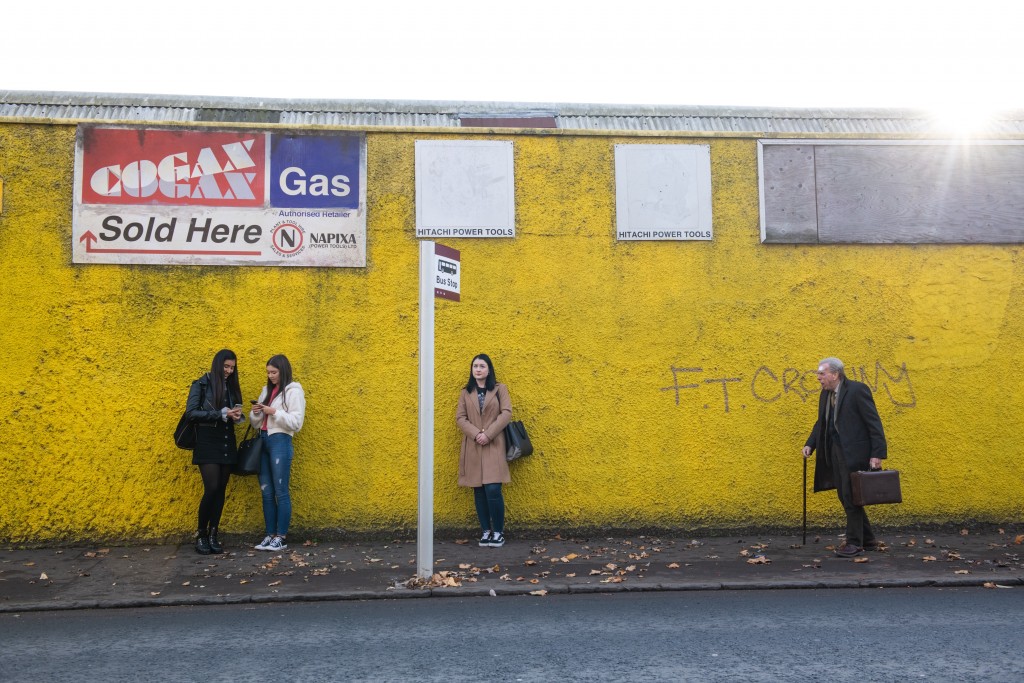The home of the Glasgow Vintage Vehicle Trust stars in a new film alongside British acting stalwart, Timothy Spall, in which his character journeys from John O’Groats to Land’s End – despite the cast and crew having never left Scotland.
Directed by Scottish filmmaker Gillies MacKinnon (Small Faces, Whisky Galore), The Last Bus was filmed across Scotland in October and November 2019 and is now set for release on Friday (27 August).
The film charts the story of 90-year-old Tom Harper (Spall) who, after the death of his wife Mary (Phyllis Logan), travels the 874 miles from their home at Scotland’s most northern mainland point to England’s most southern point, via local buses using his bus pass.
Despite the epic nature of the journey, film production never left Scotland, instead making clever use of Scottish locations and real regional buses to recreate the route.
Most of the filming took place in and around Glasgow, including at the Glasgow Vintage Vehicle Trust’s Bridgeton Bus Garage on Fordneuk Street. The exterior of the former Corporation bus garage was used for bus stops and depots, while sets were built in the interior of the museum which is home to around 130 vintage buses, coaches, commercial vehicles and fire appliances.
Other film locations included Summerlee Museum of Scottish Industrial Life in North Lanarkshire, and Dunure on the Ayrshire coast and Hunterston House in West Kilbride, both of which are familiar to Outlander fans as filming locations for the hit television series.
Touch Estate on the outskirts of Stirling acted as Tom and Mary’s cottage, with an unused house renovated by the Art and Props department to create a warm and cosy home.
The film also features many scenic shots of the beautiful landscapes in the Scottish Borders, Argyll and Highlands.
The Last Bus is just one of many productions to have taken advantage of Scotland as a backdrop in recent years – including most recently, Fast & Furious 9 (filmed in Edinburgh), Eurovision Song Contest: The Story of Fire Saga (filmed in Glasgow and Edinburgh) and The Princess Switch: Switched Again (filmed in Glasgow, Edinburgh and Lothians).
Research shows that around one in five visitors are motivated to travel to Scotland after seeing locations on the big and small screen. With the rise of streaming services and increased availability of watching Scottish-set films years after their release, screen tourism could play a more significant role in attracting visitors and boosting Scottish tourism.
Jenni Steele, Film and Creative Industries Manager at VisitScotland, said: “Big and small screen productions have always played their part in attracting visitors to locations across Scotland and it’s wonderful to have the Glasgow Vintage Vehicle Trust play a role in the production of this life-affirming and poignant tale.
“Films shot in Scotland not only boost the local economy during production but are a shop window for the country’s amazing landscapes. They provide an opportunity to promote regions across the seasons and the long-term impact allows for investment and product development to take place which enables sustainable growth in tourism.”
On filming in Scotland, Gillies MacKinnon, Director of The Last Bus, said: “The Last Bus required locations covering the entire length of the UK – John O’Groats to Land’s End. Glasgow is perfectly placed, providing a variety of urban styles and having access to a choice of landscapes within travelling distance: flatlands, mountains, lochs and coastal areas. From the city, it was easy to organise a second unit shoot for dramatic landscape further up the west coast, around Glencoe. I also knew we would get an excellent, dedicated and experienced film crew and a great pool of local actors, as I have now made a number of films based out of Glasgow. I hope I’ll be back soon to shoot another.”
The Glasgow Vintage Vehicle Trust’s collection of vehicles is only available to see on specific dates throughout the year. The Trust plans an Open Weekend on 9 and 10 October which will include many visiting vehicles and stalls, plus a high frequency bus service between the garage and city centre using its vintage vehicles.
Steven Booth, Chairman of Glasgow Vintage Vehicle Trust, said: “We at the Glasgow Vintage Vehicle Trust were delighted to have an involvement in the making of The Last Bus film. Our Bridgeton Bus Garage provided the location for a number of scenes while some of our vehicles were also used as Tom went on his travels. We feel it is important to contribute to such productions and in the process, help showcase Scotland, its visitor attractions and its heritage.”
Councillor Jim Logue, Leader of the North Lanarkshire Council, said: “There are spectacular urban and rural locations in North Lanarkshire that are enjoyed and visited by many, but those sites are also wonderful settings for film and television productions. The former Victorian ironworks site at Summerlee Museum of Scottish Industrial Life in Coatbridge features in the production of The Last Bus and provides a true insight into our industrial history including a unique exhibition hall with working machinery that were used as the backdrop for sets. It’s particularly special to see this first-class attraction feature on the big screen.”
To find out more about the Glasgow Vintage Vehicle Trust, go to www.gvvt.org






